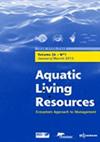How COVID-19 changed the dynamics of a fishery
IF 1.9
4区 农林科学
Q3 FISHERIES
引用次数: 0
Abstract
Northern Ireland went into COVID-19 enforced lockdown with the rest of the UK in March 2020. A stay-at-home order banned “non-essential” travel and contact with others, and closing schools and businesses. Such closures also impacted commercial fishing activities, including the Lough Neagh eel fishery. The eel fishery in Lough Neagh, Northern Ireland is the largest in Europe with an annual mean catch of around 330 t, valued at ∼£3 M. The effect of the Northern Ireland lockdown was the reduction of the Neagh fleet by 60% and delay to the start of the yellow eel fishing season by 2 months. The pandemic reduced the market demand for Lough Neagh yellow eel from ∼280,00 kg yr−1 to 100,000 kg yr−1. The objective of the study was to assess the impact of the regulations on silver eel output and the socio-economic effects on fishers and the fishery. The main impact of the market disruption was for an increase in silver eel escapement of about 15% and for those fishers who remained in the fishery, at least in the short term, a continuing livelihood. In contrast, there were direct socio-economic consequences; the fishery had to reduce in size with associated cultural and heritage loss. Upon the lifting of COVID-19 restrictions the former fleet size did not and has not returned highlighting the wide ranging socio-economic impacts from the pandemic. As of November 2023, the market demand for eel across Europe remains deflated.
COVID-19如何改变渔业动态
2020年3月,北爱尔兰与英国其他地区一起进入新冠肺炎强制封锁状态。居家令禁止“非必要”旅行和与他人接触,并关闭学校和企业。这种关闭也影响了商业捕鱼活动,包括内格湖的鳗鱼渔业。北爱尔兰内伊湖的鳗鱼渔场是欧洲最大的,年平均捕获量约为330吨,价值约300万英镑。北爱尔兰封锁的影响是Neagh船队减少了60%,黄鳝捕捞季节的开始推迟了两个月。大流行使尼格湖黄鳗的市场需求从每年约28万公斤减少到每年10万公斤。这项研究的目的是评估条例对银鳗产量的影响以及对渔民和渔业的社会经济影响。市场中断的主要影响是银鳗逃逸量增加了约15%,而对于那些仍从事渔业的渔民来说,至少在短期内,他们的生计得以继续。相反,有直接的社会经济后果;由于文化和遗产的损失,渔业不得不缩小规模。在取消COVID-19限制后,以前的船队规模没有恢复,也没有恢复,这凸显了疫情对社会经济的广泛影响。截至2023年11月,整个欧洲对鳗鱼的市场需求仍然低迷。
本文章由计算机程序翻译,如有差异,请以英文原文为准。
求助全文
约1分钟内获得全文
求助全文
来源期刊

Aquatic Living Resources
农林科学-海洋与淡水生物学
CiteScore
2.30
自引率
0.00%
发文量
10
审稿时长
>24 weeks
期刊介绍:
Aquatic Living Resources publishes original research papers, review articles and propective notes dealing with all exploited (i.e. fished or farmed) living resources in marine, brackish and freshwater environments.
Priority is given to ecosystem-based approaches to the study of fishery and aquaculture social-ecological systems, including biological, ecological, economic and social dimensions.
Research on the development of interdisciplinary methods and tools which can usefully support the design, implementation and evaluation of alternative management strategies for fisheries and/or aquaculture systems at different scales is particularly welcome by the journal. This includes the exploration of scenarios and strategies for the conservation of aquatic biodiversity and research relating to the development of integrated assessment approaches aimed at ensuring sustainable and high quality uses of aquatic living resources.
 求助内容:
求助内容: 应助结果提醒方式:
应助结果提醒方式:


